
Sany empowers intelligent port construction to achieve major breakthrough
Sany Marine Heavy Industry (Sany Marine), the port machinery subsidiary of Sany Group (Sany), has achieved a significant breakthrough with its H-Move2.0 intelligent system in the tire crane automation project at the Port of Tianjin. The system has improved the operational efficiency of tire cranes to 20 moves per hour, setting a new standard in the development of green, digital, and intelligent ports. With the upcoming COP29 and the manufacturing industries calling for net-zero development, Sany is firmly taking the path of industrial transformation with concrete actions to reach the carbon goals.
Sany Marine is committed to becoming the technology leader of logistics equipment, providing electric, intelligent, unmanned and integrated solutions for intelligent ports and supporting the green transformation of the global port machinery industry.
Faced with challenges such as energy saving carbon reduction, and intelligent development, the need for anti-shaking and anti-twisting capabilities, and labor shortages, Sany Marine's intelligent port solutions have provided significant advancements. These include real-time anti-shaking and anti-twisting technologies to ensure automated and safe operations, pushing operational efficiency beyond traditional manual methods.
Leveraging digital twin technologies, the team can predict and simulate the trajectory and position of the containers and adding the spreader lowering action to essential technical functions to achieve exceptional results. The automation efficiency of a traditional tyre crane is about 15 to 16 cycles per hour, while the new version integrating GPS, AI visualisation, and 3D scanning imaging technologies can significantly improve the signal's reliability. After four months of test trials, the No.45 machine has improved the automated working efficiency to 20 cycles per hour, surpassing manual labor for the first time in the industry.
By predicting and simulating the trajectory and position of the landing box, the action of lowering the spreader is added to the technical essentials of manual work, and the results are remarkable. The automation efficiency of a traditional tire crane is about 15 to 16 cycles per hour. The newly upgraded system has an abnormal intervention rate of only 2.78 per cent and operation ratio reaching 1:6, which means one person, can manage up to six RTGs at the same time.
"There is still potential for upgrading our carrier tools and related equipment, through which we can better utilise our resources and elevate the low-carbon and green development," said Cheng Shidong, director of Urban Transportation Centre, Institute of Comprehensive Transportation with the National Development and Reform Commission.


 +91-22-24193000
+91-22-24193000 Subscriber@ASAPPinfoGlobal.com
Subscriber@ASAPPinfoGlobal.com